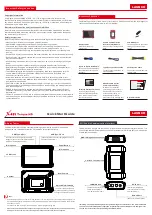
WavePro 7Zi
421
WP700Zi-OM-E-RevA
Eye Height
The eye height is a measure of the signal-to-noise ratio of a signal. The mean of the “0” level is subtracted from
the mean of the “1” level as in the eye amplitude measurement. This number is modified by subtracting the
standard deviation of both the “1” and “0” levels. The measurement basically gives an indication of the eye
opening.
Eye Width
This measurement gives an indication of the total jitter in the signal. The time between the crossing points is
computed by measuring the mean of the histograms at the two zero crossings in the signal. The standard
deviation of each distribution is subtracted from the difference between these two means.
Extinction Ratio
This measurement, defined only for optical signals, is the ratio of the optical power when the laser is in the ON
state to that of the laser in the OFF state. Laser transmitters are never fully shut off because a relatively long
period of time is required to turn the laser back on, thus limiting the rate at which the laser can operate. The
extinction ratio is the ratio of two power levels (one very near zero) and its accuracy is greatly affected by any
offset in the input of the measurement system. Optical signals are measured using optical-to-electrical converters
on the front end of the SDA. Any DC offset in the O/E must be removed prior to measurement of the extinction
ratio. This procedure is known as dark calibration. The output of the O/E is measured with no signal attached (i.e.,
dark), and this value is subtracted from all subsequent measurements.
Eye Crossing
Eye crossing is the point at which the transitions from 0 to 1 and from 1 to 0 reach the same amplitude. This is the
point on the eye diagram where the rising and falling edges intersect. The eye crossing is expressed as a
percentage of the total eye amplitude. The eye crossing level is measured by finding the minimum histogram
width of a slice taken across the eye diagram in the horizontal direction as the vertical displacement of this slice is
varied.
Average Power
The average power is a measure of the mean vale of all levels that the data stream contains. It can be viewed as
the mean of a histogram of a vertical slice through the waveform covering an entire bit interval. Unlike the eye
amplitude measurement where we separate the ones and zeroes histograms, the average power is the mean of
both histograms. Depending on the data coding that is used, the average power can be affected by the data
pattern. A higher density of ones, for example, will result in a higher average power. Most coding schemes are
designed to maintain an even ones density resulting in an average power that is 50% of the overall eye amplitude.
Q Factor or BER
The Q factor is a measure of the overall signal-to-noise ratio of the data signal. It is computed by taking the eye
amplitude (the difference between the mean values of the "1" and "0" levels) and dividing it by the sum of the
noise values (standard deviations of the "1" and "0" levels). All of these measurements are taken in the center
(usually 20%) of the eye.
Содержание DDA 7 Zi series
Страница 1: ...Operator s Manual WavePro SDA and DDA 7 Zi Series Oscilloscopes ...
Страница 2: ... L R R H HUD RU D D ...
Страница 41: ...Operator s Manual WP700Zi OM E RevA 40 The detachable WavePro Zi front panel ...
Страница 376: ...WavePro 7Zi 375 WP700Zi OM E RevA Absolute Offset Relative ...
Страница 439: ...Operator s Manual WP700Zi OM E RevA 438 ...
Страница 440: ...WavePro 7Zi 439 WP700Zi OM E RevA ...
Страница 544: ...Thank you for purchasing a WavePro SDA or DDA 7 Zi Oscilloscope ...
















































